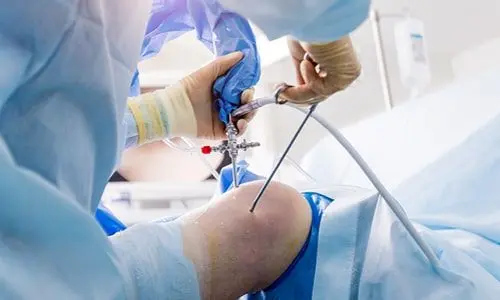
Anterior Cruciate Ligament Surgery F.A.Q.
Contents:
- Watch Anterior Cruciate Ligament Surgery
- What Happens If Anterior Cruciate Ligament Injury Is Untreated?
- Is anterior cruciate ligament surgery risky?
- How many hours does anterior cruciate ligament surgery take?
- How long does it take to recover from anterior cruciate ligament surgery?
- How will I be on the 20th day after anterior cruciate ligament surgery?
- How will I be in the 2nd month after anterior cruciate ligament surgery?
- How will I be in the 3rd month after anterior cruciate ligament surgery?
- When can I walk after anterior cruciate ligament surgery?
- Will there be problems after anterior cruciate ligament surgery?
- Will it be the same after anterior cruciate ligament surgery?
- Will there be complaints such as I cannot bend my knee after anterior cruciate ligament surgery?
- Is rehabilitation necessary after anterior cruciate ligament surgery?
- When is it possible to return to sports after anterior cruciate ligament surgery?
- Does anterior cruciate ligament surgery prevent military service?
- How is the price of anterior cruciate ligament surgery determined?
What is the Anterior Cruciate Ligament?
It is a ligament located in the middle of the knee joint (tibiofemoral joint), located between the thigh and leg bones. It extends obliquely (diagonally) within the knee joint from the front of our leg bone to the middle of the thigh bone. The anterior cruciate ligament consists of 2 parts: anteromedial (AM) and posterolateral (PL) bundle. It mainly contains type 1 collagen, but also some type 3 collagen.
Functions of the Anterior Cruciate Ligament
Anterior cruciate ligament; is the basic ligament that provides integrity of the knee (knee stability) joint during performance movements such as walking, running and jumping. It essentially prevents the tibia from sliding towards the front of the femur. In addition, it is an important structure that contributes to the rotational and lateral stability of the knee joint. In recent years; many articles have been published showing that the, the anterior cruciate ligament is a sensory organ that also contributes to deep sense of knee (proprioception sense).
Anterior Cruciate Ligament Injury Complaints
In the early period of anterior cruciate ligament tears, which are generally seen as a result of sports injuries; Severe pain, swelling (intra-articular bleeding) and limitation of movement are observed in the knee. After the acute period ends; Varying degrees of pain in the knee, a feeling of instability (stinging, turning, feeling of insecurity in the knee) and difficulty bearing weight continue. In addition to these symptoms seen in people without anterior cruciate ligament; It has been shown that complications such as meniscus tears, cartilage damage and knee joint calcification increase in the long term.
Diagnosis of Anterior Cruciate Ligament Injury
Some diagnostic tests specific to the anterior cruciate ligament are applied to people who complain of pain as a result of knee trauma. After the anterior drawer test, Lachmann test and pivot shift test performed by the orthopedic physician, patients with suspected anterior cruciate ligament injury are diagnosed definitively by MRI.
Lachmann test:
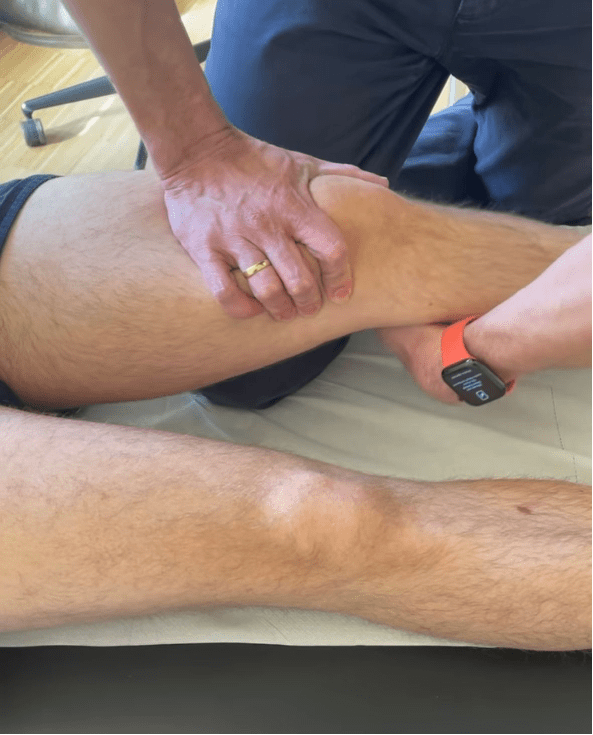
Anterior cruciate ligament seen intact on knee MRI:
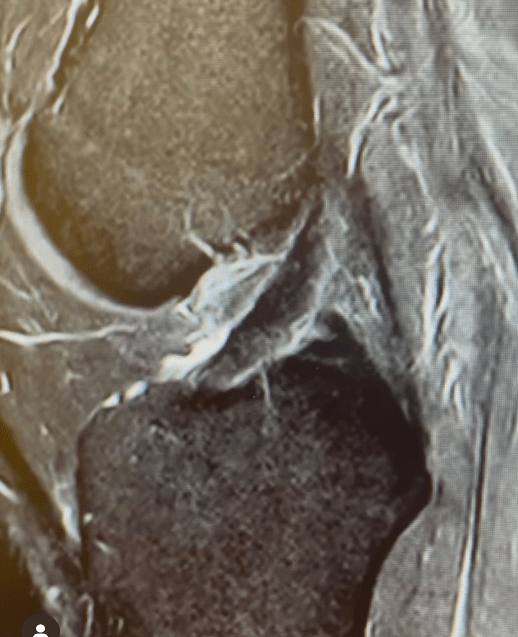
Anterior cruciate ligament torn in knee MRI:
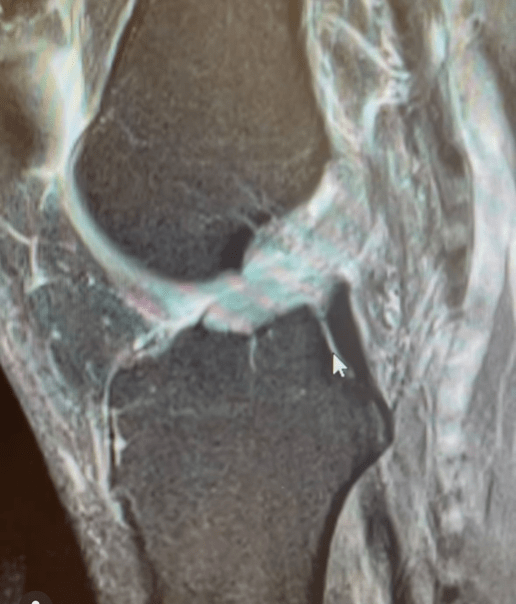
Arthroscopy image of anterior cruciate ligament partial injury:
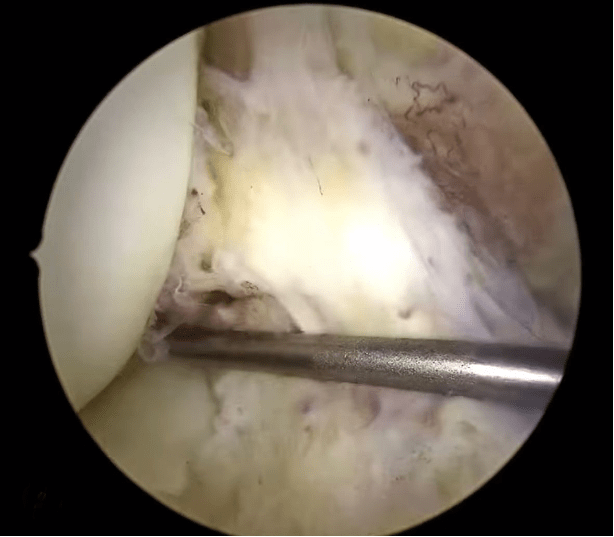
Arthroscopy image of anterior cruciate ligament full thickness injury:
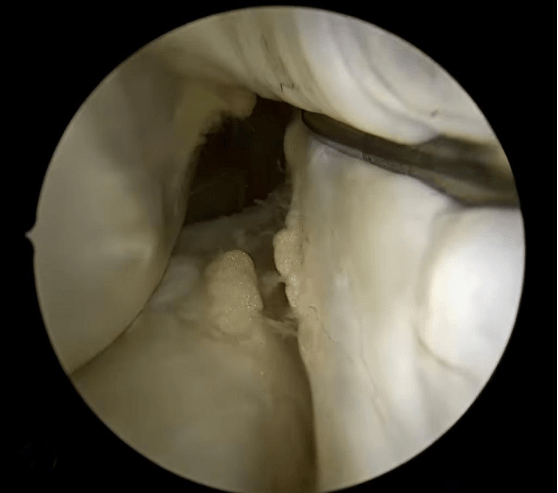
Arthroscopy image of anterior cruciate ligament full thickness injury:
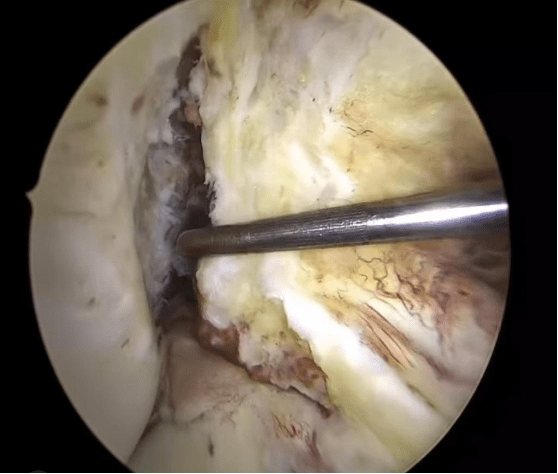
Anterior Cruciate Ligament Injury Treatment
Treatment options after anterior cruciate ligament injury vary depending on the patient's age, socioeconomic status and treatment expectations. Surgical treatment is required in almost all patients. However, non-surgical treatment options can be considered in elderly patients, patients with reduced joint range of motion and low demands. In this group, treatment is aimed by giving physical therapy, strengthening exercises and lifestyle modifications. It has been shown that ligament and meniscus injuries are also observed over time in the patient group who are not treated surgically, and in addition, cartilage damage and knee arthritis develop. For these reasons, the gold standard treatment for anterior cruciate ligament tears is; arthroscopic reconstruction surgery.
Arthroscopic view after reconstruction (new anterior cruciate ligament with ligament transplantation):
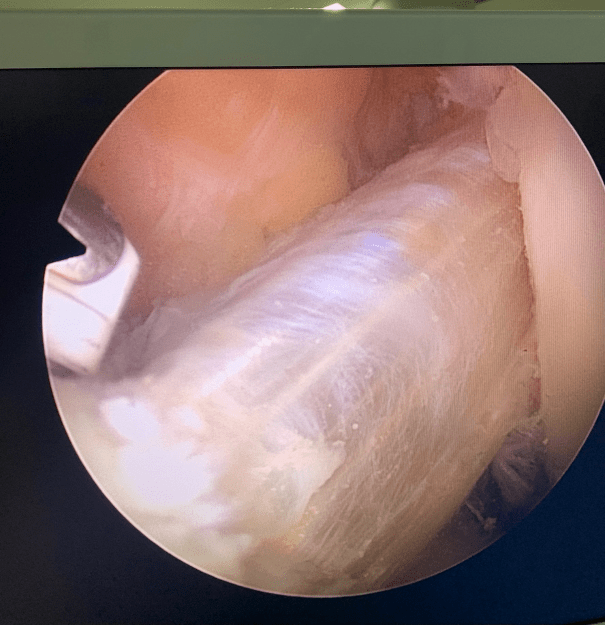
Arthroscopic Anterior Cruciate Ligament Surgery
This surgery requires an average hospital stay of 1 day. The next day after surgical treatment, the patient can walk on the operated side. Patients are subjected to a serious physical therapy and rehabilitation process in the early period. They can fully return to daily life in the 3rd week after the surgery, and can return to professional sports activities with full performance within an average of 6 months.
Watch Anterior Cruciate Ligament Surgery
What Happens If Anterior Cruciate Ligament Injury Is Untreated?
It has been shown that ligament and meniscus injuries develop over time in the patient group that is not treated surgically, and additionally, cartilage damage and knee arthritis occur. For this reason, in cases that remain untreated or neglected; It is observed that the feeling of pain, limitation of movement and instability in the knee continues to increase.
Is anterior cruciate ligament surgery risky?
Although it has some surgical risks, as in every surgery, it is generally a safe operation with a low complication rate since it is performed with a closed technique (arthroscopic). Although complications such as neesthesia-related complications or wound infection may occur, the rate is very low. This arthroscopic procedure has a faster recovery compared to open operations.
How many hours does anterior cruciate ligament surgery take?
The duration may vary depending on the patient and the surgeon performing the operation, the average duration is 1 hour. The type of graft to be taken for the anterior cruciate ligament and the condition of the meniscus are important factors that affect the duration. The most important factor that shortens the duration is surgical experience.
How long does it take to recover from anterior cruciate ligament surgery?
Patients can start walking and rehabilitation the day after the operation. People working in desk jobs can return to work after an average of 1 week. For those working in the field, the duration varies depending on the occupational group. It takes an average of 3 weeks to return to daily life, and an average of 6 months to return to active sports.
How will I be on the 20th day after anterior cruciate ligament surgery?
Although the rehabilitation period may vary between patients, the patient can walk, return to daily life, and go up and down stairs on the 20th day after surgery. The average time it takes to independently manage their own business and walk without support is 5 days. At the end of the 3rd week, they can return to their daily pace.
How will I be in the 2nd month after anterior cruciate ligament surgery?
The rehabilitation period may vary slightly between patients. In the 2nd month after the surgery, the patient can walk without a hitch and return to daily life. Can do sports such as cycling and swimming.
How will I be in the 3rd month after anterior cruciate ligament surgery?
Although the rehabilitation period may vary between patients, athletes can start personal training in the 3rd month after surgery. They return completely to daily life. Non-competitive sports; You can do swimming, cycling, jogging etc. People working in the field can continue their work in a controlled manner.
When can I walk after anterior cruciate ligament surgery?
Patients can walk on the operated side one day after the operation. Walking without limping is achieved in the 3rd week on average. Patients can run at a light pace at the end of the first month.
Will there be problems after anterior cruciate ligament surgery?
As with any surgery, there may be some surgical risks. Essentially, these risks are anesthesia-related risks and wound infections. Since arthroscopic anterior cruciate ligament surgery is performed with a closed technique (arthroscopic), it is generally a safe operation with a low complication rate.
Will it be the same after anterior cruciate ligament surgery?
Anterior cruciate ligament surgery is one of the most successful operations not only in orthopedics but in all of medicine. The most important factors in success are surgical practice and patient compliance. After a properly performed anterior cruciate ligament surgery and adequate rehabilitation in the following period, patients can achieve 100% recovery and regain their former strength.
Will there be complaints such as I cannot bend my knee after anterior cruciate ligament surgery?
In the early stages, the doctor asks the patient not to bend his knee fully for the first two weeks. Knee bending angles are gradually increased with exercises. If a successful surgery is followed by correct physical therapy and rehabilitation practices, there will be no problem such as being unable to bend the knee.
Is rehabilitation necessary after anterior cruciate ligament surgery?
The success of anterior cruciate ligament surgery is one hundred percent linked to appropriate physical therapy. Post-operative rehabilitation is an essential requirement. The most important component, along with surgical practice and patient compliance, is rehabilitation.
When is it possible to return to sports after anterior cruciate ligament surgery?
Although the rehabilitation period may vary between patients, the patient can walk without a hitch and return to daily life in the 2nd month after the surgery. Can do sports such as cycling and swimming. Full return to competitive sports such as football and basketball takes approximately 4-6 months.
Does anterior cruciate ligament surgery prevent military service?
The patient can regain his/her former strength before the injury after the operation. There is no obstacle to military service after a successful anterior cruciate ligament operation. Patients can participate in military service or similar field activities with full performance.
How is the price of anterior cruciate ligament surgery determined?
The price varies depending on the age of the patient, the type of tear, the presence of accompanying injury, and the types and number of materials to be used. There are many variables in determining the cost. Because the selection of an experienced surgical team and the use of appropriate materials are essential for the success of the surgery.

